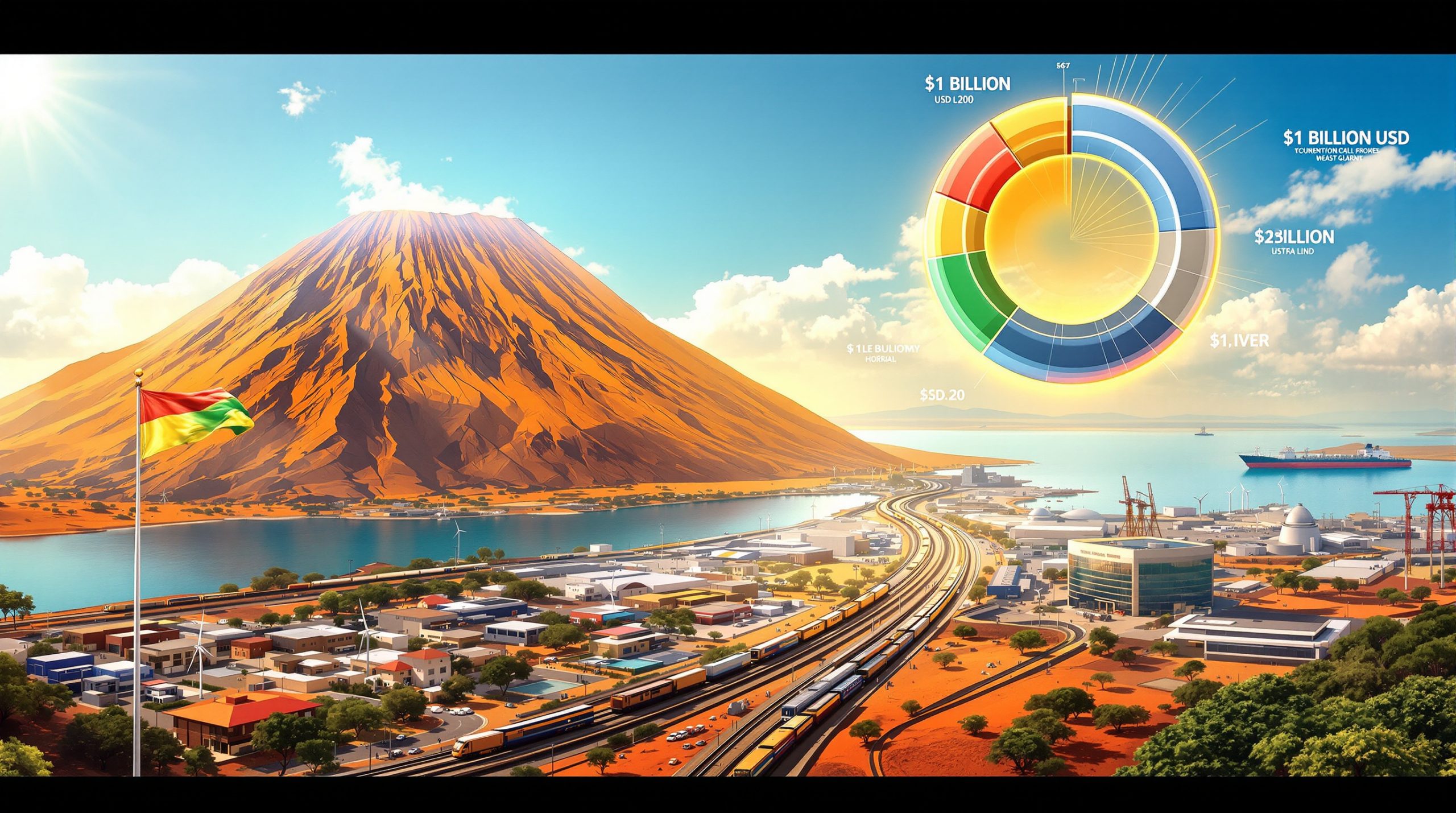How Large is the Simandou Iron Ore Project in Guinea?
The Simandou iron ore project in Guinea stands as one of West Africa's most significant mineral developments, representing a transformative asset for both regional economics and global steel markets. This massive undertaking encompasses extraordinary geological wealth that positions it among the world's premier iron ore deposits.
Scale and Resource Quality
The Simandou deposit contains 2.4 billion tonnes of proven reserves spread across four mining blocks in southeastern Guinea's mountainous terrain. What distinguishes this project from other global iron ore operations is its exceptional ore grade of 65% iron content, placing it in the premium category that commands substantial market premiums over commodity-grade materials.
The project's annual production capacity targets 120 million metric tonnes, making it what industry sources describe as the world's largest mine for the highest grade of iron ore. This production scale represents approximately 6.4% of global seaborne iron ore trade by 2030, indicating substantial market influence potential.
| Project | Annual Capacity | Ore Grade | Reserve Size |
|---|---|---|---|
| Simandou | 120M tonnes | 65% Fe | 2.4B tonnes |
| Pilbara (Australia) | 350M tonnes | 62% Fe | 2.4B tonnes |
| Carajás (Brazil) | 130M tonnes | 66% Fe | 7.2B tonnes |
Geological Significance
The 65% iron content significantly exceeds typical global iron ore grades, which commonly range from 50-62% iron content. This natural concentration reduces the need for extensive beneficiation processes prior to steelmaking, thereby reducing energy consumption and associated carbon emissions in downstream processing.
Furthermore, based on current reserve estimates and full production capacity, the Simandou operation could maintain approximately 20 years of continuous mining. However, this timeline could extend significantly with ongoing exploration and resource definition activities across the four-block structure.
Who Controls the Simandou Iron Ore Project?
The ownership structure of Simandou reflects a complex arrangement of international partnerships that combine operational expertise with market access and capital deployment. Understanding this structure reveals the strategic importance various stakeholders place on securing premium iron ore supplies.
Ownership Structure Breakdown
Winning Consortium Simandou (WCS) controls 50% of the project through ownership of Blocks 1 and 2. This Singapore-registered entity operates with majority Chinese ownership, representing 75% of the overall project's ownership concentration.
Rio Tinto SimFer manages the remaining Blocks 3 and 4 through a joint venture comprising Rio Tinto, Chalco Iron Ore Holdings, and the Guinea Government. This structure combines Rio Tinto's operational mining expertise with Chinese raw material integration and Guinean resource sovereignty, whilst maintaining alignment with Rio Tinto royalties considerations.
China Baowu Steel Group, the world's largest steelmaker by output, maintains strategic shareholding positions across both ownership structures. The company holds direct shares in WCS while maintaining indirect ownership in Rio Tinto SimFer, creating vertical integration between raw material production and steel manufacturing.
Strategic Integration Analysis
This ownership model represents sophisticated vertical integration by Chinese stakeholders. Baowu Steel Group's dual shareholding positions it as both primary user and profit participant, aligning operational incentives with end-market demands. This contrasts with traditional mining structures where producers and consumers remain separate entities.
The 75% Chinese ownership concentration enables direct supply chain integration with China's steel industry. Meanwhile, Rio Tinto's partnership provides established infrastructure development capabilities and global iron ore market experience.
What Infrastructure Will Support Simandou Operations?
The infrastructure supporting Simandou represents one of Africa's largest mining-related construction projects, requiring comprehensive transportation, port, and power systems to enable premium iron ore exports to global markets.
Transportation Network Development
The centerpiece infrastructure component involves constructing a 650-kilometre heavy-haul railway connecting the inland mining operations to coastal export facilities. This railway system requires engineering specifications capable of transporting 120 million tonnes annually, demanding specialised track gauge, gradient management, and ore car specifications.
Deep-water port facilities near Matakong provide bulk export capability directly to international markets. The terminal design eliminates transhipment requirements, enabling direct vessel loading of bulk carriers for efficient global distribution.
Regional road networks enhance logistics connectivity between mining operations and supporting infrastructure. These improvements create lasting transportation corridors benefiting multiple economic sectors beyond iron ore extraction.
Power infrastructure systems supply the substantial electricity requirements for mining operations at 120 million tonne annual scale. However, specific megawatt requirements and generation sources require further verification through technical documentation.
Investment Scale and Regional Impact
The total infrastructure investment commitment reaches $20 billion, representing comprehensive development of transportation corridors that will permanently enhance Guinea's connectivity between inland regions and international markets.
Moreover, the infrastructure development incorporates mine reclamation innovation principles to ensure long-term environmental sustainability and community benefits.
Strategic Infrastructure Legacy: These transportation corridors will create permanent economic infrastructure supporting multiple industries beyond iron ore, fundamentally transforming Guinea's logistical capabilities and regional economic integration potential.
Multi-phase construction approaches aim to minimise operational delays whilst maximising regional economic multiplier effects from construction activities. Consequently, the infrastructure development timeline must align with November 2025 production targets whilst maintaining quality standards for long-term operational reliability.
When Will Simandou Begin Commercial Production?
The Simandou iron ore project in Guinea has achieved significant operational milestones with commissioning ceremonies completed in November 2024. This indicates progression toward commercial production targets.
Production Timeline Milestones
First shipments target November 2025, representing approximately 12 months from operational activation to export commencement. This timeline allows for final equipment calibration, workforce proficiency development, and export logistics establishment.
Ramp-up phases through 2026-2027 will gradually increase capacity utilisation as mining operations optimise equipment deployment, workforce efficiency, and supply contract activation with global steelmakers.
Full production capacity of 120 million tonnes annually targets achievement by 2028. This enables maximum revenue generation and market position establishment in premium iron ore segments.
Current Operational Status
China's Vice Premier Liu Guozhong attended commissioning ceremonies in November 2024, indicating high-level political commitment to timeline adherence and operational success. The formal commissioning suggests infrastructure completion and operational systems activation are progressing according to development schedules.
Operational Readiness Factors
Key elements supporting commercial production include:
- Mining equipment deployment and commissioning processes
- Workforce training programmes and local employment development
- Environmental compliance monitoring systems activation
- Export logistics coordination with global steel industry buyers
- Supply contract negotiations with major steelmaking operations
The November 2024 commissioning timing positions the project for systematic capacity increases through 2025-2026. This builds operational confidence and market credibility before achieving full production scale.
How Will Simandou Impact Global Iron Ore Markets?
The Simandou iron ore project in Guinea will introduce substantial premium-grade supply to global markets. Consequently, this development potentially reshapes competitive dynamics and supply chain strategies for major steel producers worldwide.
Market Supply and Positioning
Simandou's 120 million tonnes annual capacity positions it to capture approximately 6.4% of global seaborne iron ore trade by 2030. However, the project's market impact extends beyond volume considerations due to its premium-grade positioning in specialised market segments.
The 65% iron content targets premium segments used for less carbon-intensive green steel production. This distinguishes it from commodity-grade iron ore that competes primarily on price. Therefore, this positioning enables value premiums whilst serving growing demand for environmentally optimised raw materials.
Supply Chain Diversification Effects
Historically, global iron ore markets have concentrated around the Australia-Brazil supply duopoly. Pilbara and Carajás operations dominating seaborne trade represent traditional iron ore price trends.
Simandou's entry reduces this concentration by providing substantial alternative supply sources for major steel producers. Furthermore, this development offers enhanced market stability through geographical diversification.
China Baowu Steel Group's strategic shareholding creates direct market access for premium ore through vertical integration. As the world's largest steelmaker by output, Baowu can absorb substantial Simandou production directly, reducing market price volatility concerns whilst ensuring demand certainty.
Premium Market Segment Analysis
The premium iron ore segment, characterised by 65%+ iron content, commands higher prices than commodity grades due to:
- Reduced energy requirements in steel production processes
- Lower carbon emissions during processing
- Enhanced efficiency in modern steelmaking technologies
- Green steel compatibility for environmentally conscious applications
Simandou's positioning in this segment provides insulation from commodity price fluctuations. In addition, it serves specialised market demand that continues expanding with decarbonisation trends, reflecting broader iron ore demand insights.
Competitive Market Integration
Market Integration Strategy: Baowu's chairman emphasised the project would provide green raw materials for the steel industry in China and globally, indicating direct integration with evolving steel industry environmental standards.
Initial market entry may create short-term oversupply conditions. However, premium-grade positioning should maintain value premiums through differentiated market segmentation rather than direct volume competition with commodity iron ore sources.
What Economic Benefits Will Guinea Experience?
The Simandou iron ore project in Guinea represents a transformative economic development opportunity. The potential impacts extend far beyond direct mining revenues to encompass infrastructure, employment, and regional development benefits.
Direct Economic Contributions
Government revenue streams will include multiple components:
- Royalty payments based on percentage of gross revenue from ore extraction
- Corporate taxation on mining operations and associated business activities
- Equity participation returns from Guinea Government's shareholding in project infrastructure
- Export duties and customs revenues from iron ore shipments
GDP contribution estimates suggest potential increases of 20-25% in national economic output. However, these projections require verification through detailed economic impact modelling based on current baseline economic conditions.
Employment and Skills Development
Direct employment creation encompasses thousands of mining jobs across extraction, processing, transportation, and support operations. Indirect employment opportunities multiply these effects through supply chain services, construction activities, and regional commerce expansion.
Skills development programmes transfer advanced mining technologies and operational expertise to Guinean workforce participants. These capabilities create lasting human capital improvements applicable across multiple industrial sectors.
Technology transfer initiatives introduce modern mining practices, equipment operation, and project management capabilities. Therefore, these enhance Guinea's overall industrial competency.
Infrastructure Legacy Benefits
The 650-kilometre railway system creates permanent transportation infrastructure connecting inland regions to coastal ports. This corridor enables:
- Agricultural product transportation from interior regions to export markets
- Regional trade facilitation between Guinea and neighbouring countries
- Industrial development opportunities along transportation corridors
- Tourism access improvements to previously isolated regions
Port facility development near Matakong enhances Guinea's maritime trade capacity beyond iron ore exports. This supports diversified economic development initiatives.
Regional Development Catalyst Effects
- Industrial cluster formation potential around transportation infrastructure
- Value-added processing opportunities for iron ore and other minerals
- Regional economic integration with West African trade networks
- Foreign direct investment attraction to additional industrial projects
Long-term Development Impact: The infrastructure investments create lasting economic assets that will continue generating benefits long after mining operations conclude, fundamentally transforming Guinea's economic geography and development potential.
What Environmental and Social Challenges Exist?
Large-scale mining operations like Simandou present significant environmental and social considerations. These require comprehensive management strategies to ensure sustainable development outcomes for local communities and ecosystems.
Environmental Risk Management Framework
Habitat preservation measures must address biodiversity protection in mining areas, particularly given Guinea's ecological significance in West African environmental systems. Comprehensive environmental impact assessments guide mitigation strategies for wildlife, vegetation, and ecosystem preservation.
Water resource management becomes critical given mining operations' substantial water requirements and potential contamination risks. Sustainable usage protocols and pollution prevention systems require ongoing monitoring and technological implementation.
Air quality management addresses dust control and emissions from mining operations, transportation activities, and processing facilities. Monitoring systems track particulate matter and ensure compliance with international environmental standards.
Land rehabilitation planning establishes post-mining restoration protocols to return affected areas to productive use after extraction activities conclude. These plans require long-term financial commitments and technical expertise for successful implementation.
Community Engagement and Social Investment
Resettlement programmes must provide fair compensation and alternative livelihoods for communities affected by mining operations. International best practices emphasise community consultation, transparent processes, and long-term support for displaced populations.
Benefit-sharing mechanisms ensure local communities receive tangible benefits from resource extraction activities. These arrangements typically include:
- Community development funds for infrastructure improvements
- Education and healthcare facility investments
- Local business development programmes and supply chain participation
- Cultural preservation initiatives protecting traditional practices
Transparency initiatives establish regular community consultation processes and public reporting on environmental performance. These include social investments and economic contributions.
International Standards Compliance
The project incorporates international best practices for environmental management. This includes comprehensive impact assessments and mitigation strategies aligned with global mining industry standards.
Environmental Commitment: Successful implementation requires ongoing monitoring, adaptive management approaches, and sustained investment in environmental protection technologies throughout the project lifecycle.
Regulatory frameworks must align with both Guinea's national environmental requirements and international standards. These are expected by global steel industry partners and financing institutions.
How Does Simandou Support Green Steel Production?
The Simandou iron ore project in Guinea specifically targets the premium market segment essential for green steel production. This positions it as a key supplier for the steel industry's decarbonisation efforts.
Premium Ore Advantages for Green Steel
Reduced carbon footprint results from Simandou's 65% iron content, which significantly exceeds typical iron ore grades. Higher iron concentration means less energy consumption during steel production processes, directly reducing carbon emissions per tonne of finished steel.
Green steel compatibility makes premium-grade ore essential for hydrogen-based steelmaking technologies. These emerging processes require high-quality raw materials to achieve optimal efficiency and environmental performance targets.
Processing efficiency improvements occur when steelmakers use higher-grade ore, requiring fewer processing steps compared to lower-grade alternatives. This efficiency translates into reduced energy consumption and lower overall environmental impact.
Technology Integration for Sustainability
Modern mining techniques employed at Simandou incorporate environmental impact minimisation strategies, including:
- Digital monitoring systems for operational efficiency optimisation
- Renewable energy integration possibilities for mining operations
- Waste minimisation protocols and resource efficiency improvements
- Carbon offset opportunities through reforestation and sequestration projects
Strategic Market Positioning
Baowu Steel Group's commitment to providing green raw materials for the steel industry in China and globally indicates direct market alignment with decarbonisation trends. This positioning ensures Simandou's production serves the growing demand for environmentally optimised steel production inputs.
Green Steel Integration: The premium-grade positioning enables Simandou to command value premiums whilst serving specialised demand from steelmakers implementing environmental standards and carbon reduction targets.
Circular economy integration potential exists through waste minimisation strategies and resource efficiency improvements. These reduce overall environmental impact whilst maintaining production efficiency.
In addition, the project's approach may influence broader considerations around onslow iron haulage operations and safety protocols throughout the industry.
What Are the Long-Term Prospects for Simandou?
The Simandou iron ore project in Guinea represents a multi-decade development opportunity with expansion potential extending well beyond initial production targets and timeline horizons.
Production Expansion and Resource Longevity
Reserve sustainability based on 2.4 billion tonnes of proven reserves supports approximately 20 years of continuous mining at full 120 million tonne annual capacity. However, ongoing exploration activities across the four-block structure could substantially extend operational longevity through additional resource definition.
Capacity optimisation potential exists beyond initial 120 million tonne targets through:
- Technology upgrades improving extraction efficiency
- Equipment expansion increasing processing capabilities
- Infrastructure enhancement supporting higher throughput volumes
- Operational improvements reducing bottlenecks and maximising utilisation
Value-added processing opportunities could develop local steel production capabilities. This would transform Guinea from raw material exporter to value-added manufacturer within regional and global steel supply chains.
Regional Development Catalyst
Industrial cluster formation around Simandou's infrastructure creates potential for:
- Downstream processing facilities for iron ore concentration and pelletisation
- Steel production operations serving regional and international markets
- Manufacturing industries utilising transportation and power infrastructure
- Service sector development supporting expanded industrial activities
Regional trade hub development leverages the 650-kilometre railway and deep-water port facilities. This facilitates broader West African commerce beyond iron ore exports.
Skills and technology centre establishment could position Guinea as a mining expertise hub for West Africa. This would attract additional mineral development projects and create lasting human capital advantages.
Global Supply Chain Evolution
Strategic market positioning in evolving global steel markets enables adaptation to changing environmental regulations and industry standards. Premium-grade ore positioning provides flexibility to serve specialised applications as they develop.
Long-term partnership development with major industrial consumers creates stability through multi-decade supply relationships. These support sustained operations and ongoing investment.
Decarbonisation contribution through premium raw materials supports global steel industry environmental transition efforts. This ensures continued market relevance as sustainability requirements intensify.
Transformational Development: Simandou's long-term prospects extend beyond mining operations to encompass comprehensive economic transformation for Guinea, regional infrastructure development, and global steel industry supply chain diversification.
Economic diversification platform potential enables Guinea to leverage mining success into broader industrial development. This reduces economic dependence on single commodity exports whilst building lasting competitive advantages.
Ready to Capitalise on the Next Major Iron Ore Discovery?
Discovery Alert's proprietary Discovery IQ model delivers instant notifications on significant ASX mineral discoveries, empowering subscribers to identify actionable opportunities ahead of the broader market. Discover how historic discoveries can generate substantial returns and begin your 30-day free trial today to position yourself ahead of the competition.




